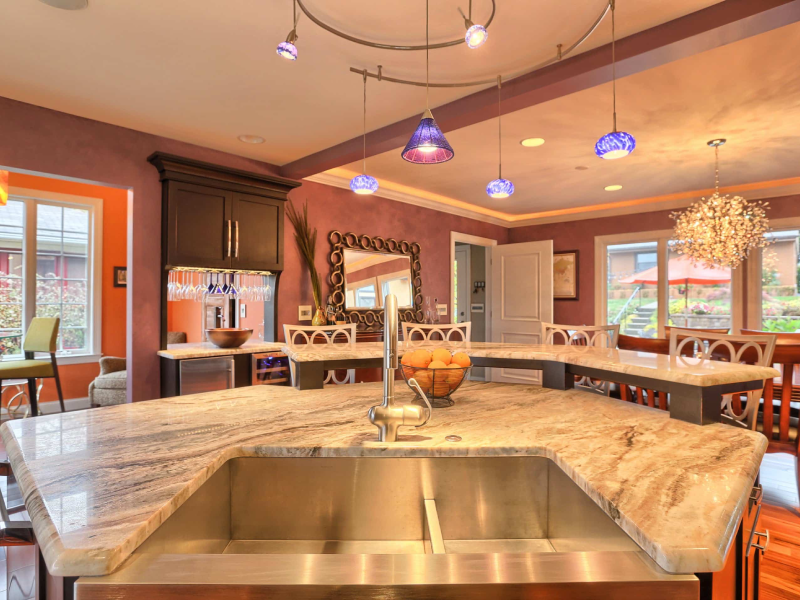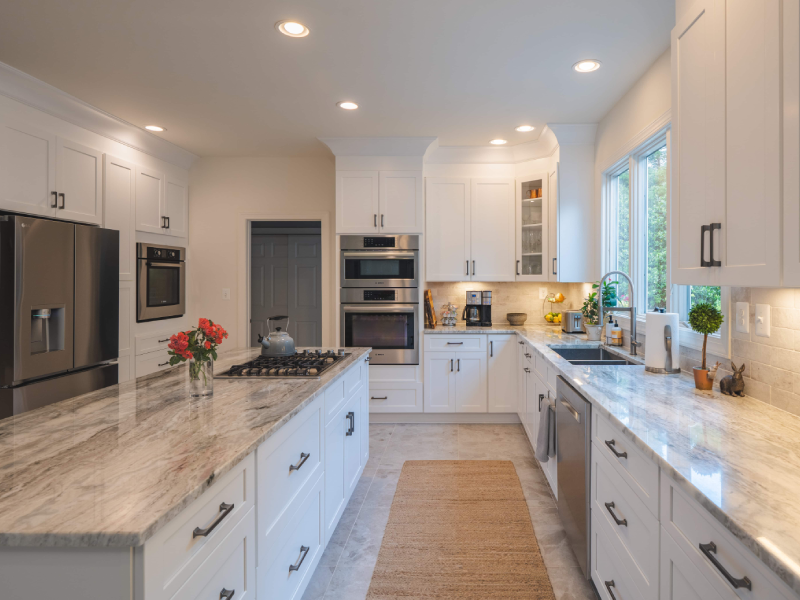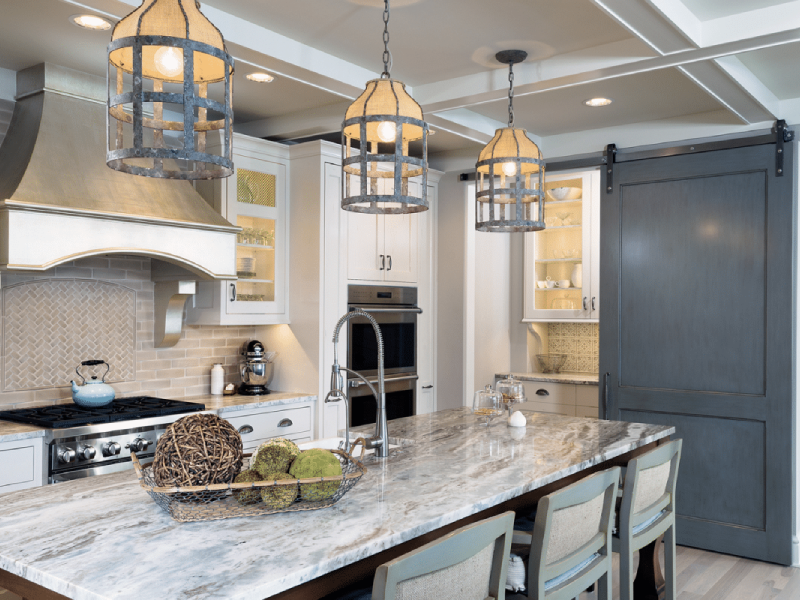You’ve probably come across Fantasy Brown being called granite, marble, or quartzite. That’s common — and honestly, it’s why so many people feel stuck when deciding whether to use it. The names change depending on where you’re buying from, and that can make it harder to understand what you’re actually getting.
If you’re thinking about using Fantasy Brown in your kitchen, bathroom, or flooring, you probably have some very practical questions:
Does it stain? Will it last? What does it cost? Is leathered better than polished? And what should you pair it with?
This guide walks through everything you need to know — from what Fantasy Brown really is, to how it behaves in daily use, to whether it fits your kind of space. The idea is to clear up the confusion, so you can choose with more confidence and fewer surprises later.

What is Fantasy Brown?
Fantasy Brown (also sold as “Brown Fantasy” or Sawar/Savar - named after the Sawar region in Rajasthan, India where it's quarried) is a striking natural stone known for its swirling brown, gray, and cream veins. Despite often being marketed as granite, quartzite, it is geologically a type of dolomitic marble – harder than typical marble but not true quartzite.
Fantasy Brown contains calcium carbonate (a component of marble) along with dolomite minerals and quartzite particles, resulting in a stone that's harder than traditional marble but not as hard as true granite or quartzite.
Fantasy Brown slabs typically show dynamic brown-gray veins on a light background. For example, slabs display diagonal movement of warm browns and creams mixed with pewter or gray accents. As some describes, it has a “flowing pattern of pewter, apricot, and chestnut tones” while some emphasizes “brown veining plus offsetting cream and white tones” for a dramatic look. Even the some experts slab gallery notes “veins of white, brown and grey with black spots” in Fantasy Brown. In short, the stone’s palette ranges from warm tan and apricot to cool grays and browns. (Note: Because patterns vary slab to slab, it’s wise to view full slabs in person before choosing to ensure you like the particular mix of colors and veining.)
Origin of Fantasy Brown Granite
Fantasy Brown comes almost exclusively from the Sawar area, which is part of Ajmer district in Rajasthan, India. Sawar (also spelled Savar) is a well-known quarrying zone for dolomitic marble, which includes varieties like Fantasy Brown. The region lies near the Aravalli mountain belt, which is rich in natural stone resources.
After quarrying, blocks from Sawar are typically sent to processing units in Kishangarh, Udaipur, or Jaipur for slab cutting, finishing, and export. The stone’s international shipments typically originate from ports like Mundra, reflecting its status as a major export from India.
Fantasy Brown is one of the most widely used stones for kitchen countertops in the United States. Its warm tones pair well with white cabinets, dark wood, or modern farmhouse designs — a favorite among American homeowners and interior designers.
Why is Fantasy Brown often confused for granite, marble, or quartzite?
Fantasy Brown is a captivating natural stone with unique properties that cause it to be frequently misidentified as granite, quartzite, or even marble. Fantasy Brown's official name is Sawar Marble, but it is more commonly recognized as Fantasy Brown Granite or Marble.
This confusion stems from its unique characteristics, blending the visual appeal of marble with the enhanced durability often associated with granite and quartzite.
Here's why Fantasy Brown is often confused:
- Dolomitic Composition: Fantasy Brown is a type of dolomitic marble, meaning it has undergone a process called dolomitization which increases its hardness and durability compared to traditional marble. Fantasy Brown is considered a "hard marble" or "dolomitic marble" due to its enhanced hardness and durability, setting it apart from traditional marbles.
- Appearance: Its flowing, vein-like patterns, often in warm earthy tones, can resemble the aesthetics of both marble and some quartzite varieties. Fantasy Brown displays colors like whispery white, gray, warm beige, gold, and earthy brown, which adds to its visual confusion with other stones.
- Performance: Fantasy Brown is more resistant to scratches and etching than conventional marble, but not as hard as true granite or quartzite. It behaves like a harder stone in some ways, but it's important to remember that it's still marble and requires proper care.
- Marketing and Nomenclature: Stone suppliers sometimes label it as "soft quartzite" or "Fantasy Brown Granite" to emphasize its increased hardness and appeal to a broader market, which further contributes to the confusion.
By understanding these characteristics, it becomes clearer that Fantasy Brown, while possessing unique durability for a marble, should be handled with the care associated with other marble varieties.
What is Hardness of Fantasy Brown?
When discussing the hardness of Fantasy Brown, it's important to understand that while it's often marketed as granite or quartzite, it's actually a type of dolomitic marble. This means its hardness falls somewhere between traditional marble and granite/quartzite.
Based on the Mohs scale of hardness, Fantasy Brown typically ranks around 4.
Here's how that compares to other popular natural stones:
- Marble: Generally falls between 3 and 5 on the Mohs scale,
- Granite: Ranks between 6 and 7 on the Mohs scale,
- Quartzite: Scores around 7 on the Mohs scale.
Fantasy Brown's dolomitic nature makes it harder and more resistant to scratching and etching compared to standard marble, which is why it's sometimes called "hard marble" or "soft quartzite". However, it's still softer than true granite or quartzite and is more susceptible to damage than those stones.
To help minimise scratches and potential etching, selecting a honed or leathered finish for Fantasy Brown countertops is recommended.
Why Sealing is Essential for Fantasy Brown (a Porous Marble)
Yes, Fantasy Brown, being a type of marble, is porous. Although it is harder than traditional marble due to its dolomitic composition, it is still more absorbent than granite or quartzite. This means that Fantasy Brown can absorb liquids and stains more easily compared to harder stones like granite or quartzite. It is crucial to implement proper maintenance practices to prevent staining and ensure its longevity.
Fantasy Brown requires sealing to prevent stains and moisture absorption. Regularly sealing the stone ensures its longevity and helps preserve its beauty.
In comparison:
- Granite: Granite is a naturally porous and absorbent stone, but is less porous than marble. It needs to be sealed to prevent staining and damage from various substances like water and oil.
- Quartz: Engineered quartz is non-porous and therefore highly resistant to staining and doesn't require sealing.
- Limestone: Similar to marble, limestone is also porous and highly susceptible to etching from acidic substances.
In summary, despite its enhanced hardness as a dolomitic marble, Fantasy Brown remains porous and requires proper sealing to protect its surface from stains and maintain its appearance
Is Fantasy Brown Scratch Resitant just like Granite?
Brown Fantasy is not entirely scratch-resistant. Although it’s more durable than standard marble, it does not match the scratch resistance of granite countertops. To reduce the appearance of scratches, consider choosing a honed or leathered finish for your Brown Fantasy surfaces.
How Heat Resistant is Fantasy Brown?
When considering Fantasy Brownfor your kitchen, it's important to understand its heat resistance relative to other materials.
- Moderate Heat Resistance: Fantasy Brown, despite being a type of marble, has moderate heat resistance and can handle everyday kitchen heat, like hot pots and pans. This is due to its dolomitic nature, which makes it harder than traditional marble.
- Less Heat Resistant Than Granite: It's not as heat-resistant as granite, Granite is known for its ability to withstand high temperatures without damage, typically up to 480°F (250°C).
- Preventing Damage: To protect your Fantasy Brown countertops and ensure their longevity, it's recommended to use trivets or hot pads when placing hot cookware on the surface. This helps prevent potential damage from prolonged or direct heat exposure. It can also prevent thermal shock, a sudden change in temperature that can cause cracking or discoloration.
In summary, Fantasy Brown offers a good level of heat resistance for daily kitchen use, but taking precautions like using trivets will help maintain its beauty and extend its lifespan.
Fantasy Brown vs Other Natural Stones
Because of its mixed identity, buyers often wonder how Fantasy Brown compares to true granites or quartzites. In general, granite is harder, more scratch- and chip-resistant, and can withstand just about anything in a busy kitchen. Fantasy Brown (a marble/dolomite) trades some of that toughness for richer veining and warmth.Some suppliers market a “Brown Fantasy Quartzite” – but often this is simply the same Fantasy Brown stone sold as quartzite.| Stone Type | Mohs Hardness | Porosity | Needs Sealing | Heat Resistance | Scratch Resistance |
|---|---|---|---|---|---|
| Fantasy Brown | 4 | Medium (Porous) | Yes (Every 6–12 mo) | Moderate | Medium |
| Granite | 6–7 | Low | Occasionally | High | High |
| Quartzite | ~7 | Very Low | Rarely | Very High | Very High |
| Marble | 3–4 | High (More Porous) | Yes (Often) | Low to Moderate | Low |
quartzite is even harder than granite and very stain/etch resistant, but usually comes in cooler or lighter color schemes. Fantasy Brown, by contrast, has warmer browns and creams. Ultimately, your choice depends on whether you prioritize durability (granite/quartzite) or aesthetic (Fantasy Brown’s unique veining).

Popular Surface Finishes
Fantasy Brown, a popular natural stone is available in a variety of surface finishes, each with its own distinct appearance and maintenance requirements.
- Polished: This classic finish creates a glossy, reflective surface that enhances the stone's color and highlights its intricate veining. Polished Fantasy Brown is less porous than honed or leathered finishes, requiring less frequent resealing.
- Honed: A honed finish yields a matte surface for a softer, contemporary look. Honed Fantasy Brown is more absorbent and typically requires sealing every 6–12 months.
- Leathered (Brushed): This textured matte finish offers a gentle sheen and tactile feel, giving the stone a rustic, muted appearance. Leathered Fantasy Brown is also more absorbent than polished and requires sealing every 6-12 months.
Regardless of the chosen finish, all Fantasy Brown surfaces require regular sealing to protect them from stains and moisture absorption.
How to Pick the Right Fantasy Brown Granite for Your Project
Brown Fantasy marble often features natural fissures or cracks. These imperfections are a common characteristic of the stone. To ensure you’re satisfied with the final product, it’s crucial to inspect the slab closely before finalizing your order and layout. For more detailed information about natural stone imperfections like Fantasy Brown marble is not suitable for outdoor projects due to its low porosity, low scratch resistance, susceptibility to etching, presence of fissures, and overall delicate nature.
Application of Fantasy Brown Granite
Fantasy Brown granite, with its striking patterns, is perfect for a range of applications. Use it for kitchen countertops, bathroom vanities, bar tops, and fireplace surrounds. Its durability and elegance also make it a great choice for flooring and wall cladding.

Price of Fantasy Brown Granite
It is also referred to as Sawar marble, this stone offers a versatile range of finishes, including Polished, Honed, and Leathered, making it suitable for applications such as book-matched flooring and wall cladding.
In India, retail prices are roughly equivalent to the above (around ₹200–300 per sq.ft. for a good slab), making Fantasy Brown more affordable than many exotic marbles. (Indian exporters emphasize its “durable, attractive and affordable” price. Fantasy Brown slabs are typically stocked in 2cm and 3cm thicknesses.
Overall, Fantasy Brown offers a lower-cost alternative to Italian, Turkish or Greek marbles with a similar luxurious look
Conclusion
Fantasy Brown is a beautiful, earth-toned stone that’s often marketed like granite or quartzite but is actually a very hard marble (dolomite). It’s popular for countertops and tiles thanks to its dramatic pattern. With the right finish and routine sealing, it performs well in kitchens and baths. When selecting this stone, view full slabs (to check color variation) and consult with your fabricator about finish and sealing. Pair it with a simple backsplash in a coordinating neutral shade to let the stone’s pattern shine. With those considerations, Fantasy Brown can be a stunning, timeless choice for your project.
Ready to explore the stunning possibilities of Fantasy Brown for your next project? At Stone Galleria, we specialize in high-quality granite and quartzite, including Fantasy Brown. Let us help you bring your vision to life with the finest natural stone available!
Learn About Other Popular Indian Granite
Looking for the right granite? Fantasy Brown offers flowing patterns, while P White and Alaska White suit minimal, modern looks. For bolder styles, go with Markino Black, Black Galaxy, Ash Black or the Lakha Red Granite—each one brings its own charm to your project. Read more about these products.
- Alaska White Granite: Everything You Need to Know
- Alaska Gold Granite: Luxury Flooring Option
- Black Markino Granite: Everything You Need to Know
- Why Is Patagonia Quartzite Ideal for Countertops?
- P white Granite: Classical Yet Affordable Salt & Pepper Granite
- Complete Guide to Rajasthan Black Granite: Features, Applications & Rates








